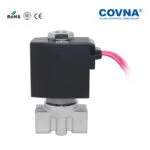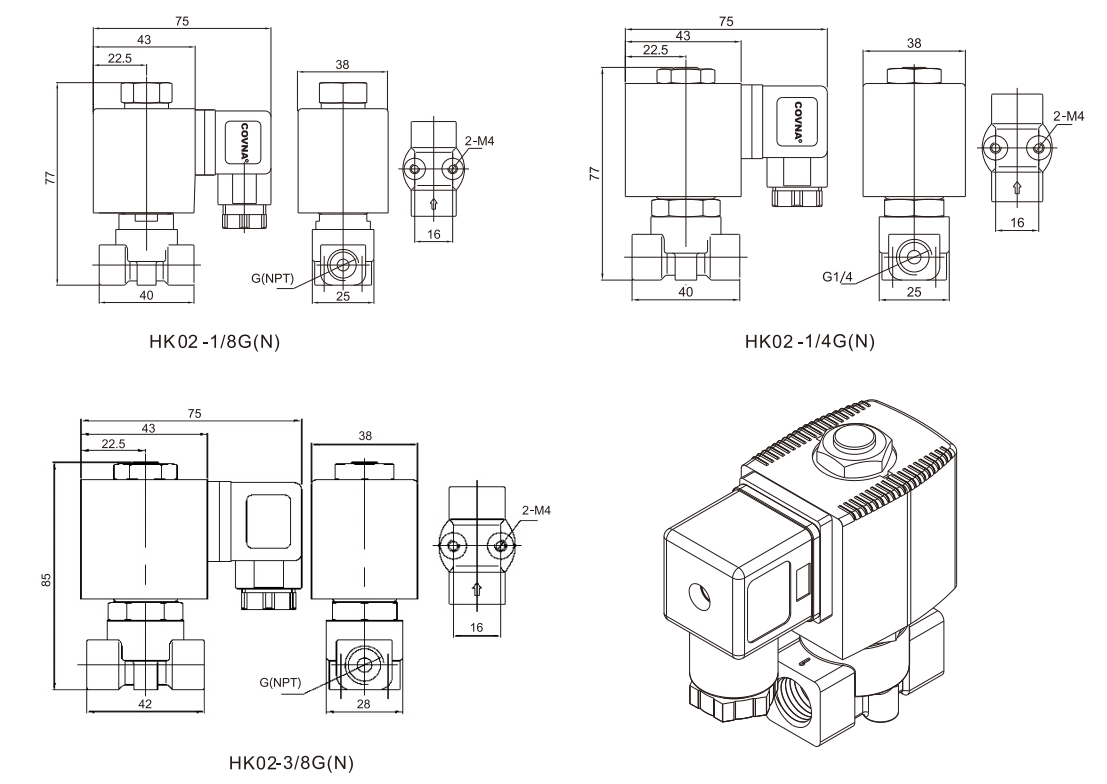











COVNA HK02-S Compact Design Solenoid Valve – Stainless Steel
HK02-S Stainless Steel Compact Design Solenoid Valve
with direct-acting mini construction at low power consumption. Compact design to save space. Applied to low-pressure system, open from 0 bar. Quick response. Large Stock.
COVNA is a solenoid valve supplier and we helped more than 1000 companies with automation solutions with our valve. Consult us to get the valve solution!
Model
- Function: Normally Closed
- Pressure: 0 to 16 bar
- Voltage: DC-12V, 24V; AC-24V, 120V, 240V/60Hz; 110V, 220V/50Hz
- Temperature of Media: -10 to 180℃ (14℉ to 356℉)
- Suitable Media: Air, water, steam, oil, gas, etc
- Material: Stainless Steel
● Direct acting mini construction at low power consumption
● Compact design to save the space
● Pressure range from 0 to 16 bar
● Widely used in ventilator machine and other small machine
● Available in brass and stainless steel material for your choice
| Port size | 1/8″, 1/4″, 3/8″ | Orifice(mm) | 1.0, 1.6, 2.5, 3.0, 4.0, 5.0, 6.0 |
| Port Thread | NPT, G | Function | Normally Closed / Normally Open |
| Pressure | 0 to 10 bar | Voltage | DC-12V, 24V; AC-24V, 120V, 240V/60Hz; 110V, 220V/50Hz |
| Temperature of Media | -10 to 180℃(14℉ to 356℉) | Suitable Media | Water, Air, Oil, Gas, etc |
| Material | Stainless Steel | Applications | Water treatment, automatic machines, ventilator, etc |

![]()
- 2W21 12V solenoid valve are automatic solenoid valves for gas water, oil. They are easy and safe to operate.
- This normally used solenoid valve can be used in many fields, usch as, Air, City Gas, Water, Oil, Petroleum, Environemtal Protection, etc.
- Suitable for low head and zero head applications with a coupled diaphragms
![]()

| Port Size | 3/8”~2” | Orifice(mm) | 15, 20, 25, 32, 40, 50 |
| Port Thread | BSPP, BSPT, NPT, FLANGE | Function | Normally closed or opened |
| Pressure | 0-1.0 MPa (10 bar) | Voltage | DC-12V, 24V; AC-24V, 120V, 240V/60Hz; 110V, 220V/50Hz |
| Temperature of media | -10~100℃ (14℉ to 212℉) | Suitable Media | Water, gas, oil, etc |
| Material | Brass, Stainless Steel | Sealing Material | NBR, VITON, PTFE, EPDM |
| Coil | S51B,30VA(AC),24W(DC),IP65,100%ED | ||
| Coil | SD01B,28VA(AC),36W(DC),IP65,100%ED | ||
1.Oil and Gas Industry
Pipeline Flow and Pressure Control: Used for flow and pressure control in natural gas and oil pipelines to ensure stability during transportation.
Gas and Liquid Distribution Systems: Regulates the flow of gases or liquids, ensuring precise control under various operating conditions.
Automation of Distribution Systems: Used in refineries and natural gas processing plants to automate fluid distribution and regulate the reaction processes.
2.Chemical and Petrochemical Industry
Reactor Pressure and Flow Control: Used in chemical reactors, storage tanks, and other equipment to control pressure and flow, ensuring stability in the chemical reaction process.
Flow/Pressure Regulation: Regulates the flow of liquids or gases in processes such as polymerization, refining, and distillation to ensure efficient production.
Steam Control: Regulates the flow and pressure of steam in steam generators and distribution systems.
3.Water and Wastewater Treatment
Water Flow Control: Regulates water flow and pressure in water supply and wastewater treatment systems to ensure normal operation.
Gas and Chemical Additions: Regulates the flow of chemicals or gases (such as chlorine or ammonia) added during the water treatment process.
4.HVAC (Heating, Ventilation, and Air Conditioning) Systems
Temperature Control and Airflow Regulation: Used in air conditioning systems to regulate the flow of cooling or heating fluids to maintain the desired temperature.
Pressure and Airflow Regulation: Adjusts the flow and pressure of air in ventilation, air conditioning, and humidification systems to ensure indoor comfort.
5.Food and Beverage Industry
Liquid Flow Control: Precisely controls the flow of liquids in processes such as brewing, dairy production, and beverage bottling.
Temperature and Pressure Regulation: Regulates temperature and pressure during heating, cooling, and sterilization to ensure product quality and safety.
6.Pharmaceutical Industry
Precision Flow Control: Regulates the flow of liquids and gases in pharmaceutical manufacturing processes to ensure precise control of process parameters.
Pressure Control: Adjusts pressure in cleaning and sterilization systems to ensure stable system operation.
7.HVAC Systems
Airflow and Temperature Control: Controls the flow and temperature of air to adjust environmental conditions, ensuring comfort and energy efficiency inside buildings.
8.Steel and Metallurgical Industry
Gas Flow Control: Precisely adjusts the flow of gases such as oxygen and nitrogen during smelting and heating processes to ensure stable furnace temperatures and chemical reactions.
Cooling Fluid Flow Regulation: Regulates the flow of cooling fluids in cooling systems to ensure temperature control of equipment.
9.Thermal and Power Industry
Steam and Water Flow and Pressure Control: Regulates the flow of steam and water in boiler systems, heat exchangers, and power plants to ensure efficient operation of thermal systems.
10.Mining Industry
Slurry Flow Regulation: Adjusts the flow and pressure of slurry during transportation and separation processes to ensure efficient extraction and processing of minerals.





